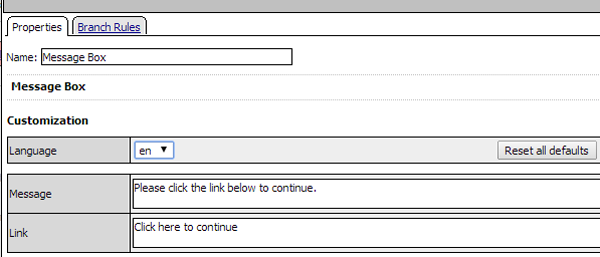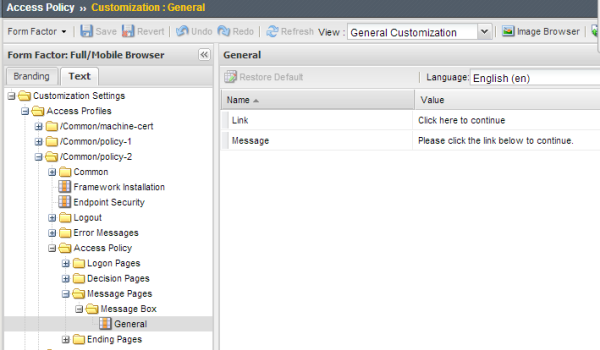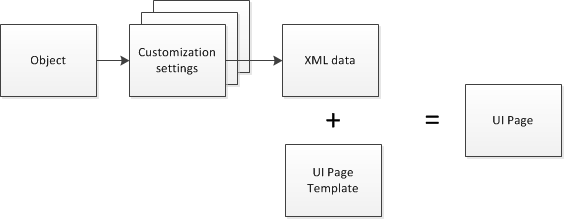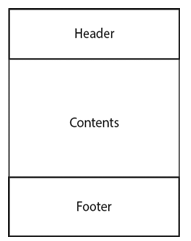Applies To:
Show Versions
BIG-IP APM
- 11.6.5, 11.6.4, 11.6.3, 11.6.2, 11.6.1
Overview: Customization and localization
Customization and localization are ways to change the text and the language that users see, and to change the appearance of the user interface for Access Policy Manager.
About basic, general, and advanced customization
The Customization tool provides three types of customization.
- Basic
- Basic customization provides a limited set of options intended for quick modification of the objects that are most commonly displayed to users. It can be used to customize and localize common text labels and captions for objects. It can also be used to configure the basic look and feel for pages.
- General
- General customization enables configuration of a few additional objects and provides many
more options for customizing objects, such as:
- The size, color, and placement of forms and screens.
- The look and feel of objects with more opportunities to replace images.
- Text on the screen, including headers and footers.
- Messages, including installation and error messages.
- Advanced
- Advanced customization provides for any customization that can be effected using Cascading Style Sheets (CSS) and HTML.
About language choices
The set of languages that are available for use in an access policy is specified in the access profile. When customizing access profile objects, the accepted languages for the access profile are available for selection. When customizing resource objects, the languages for all access profiles are also available for selection.
About localization in the generated UI
Access profile objects and resource objects can have different language settings from one another. If it is available, the language of the user session is selected for use in the UI; otherwise, the default language for the access profile is selected.
About visual policy editor and general customization similarities
Some access policy items can be customized using either the visual policy editor or the Customization tool. After changes are made and saved in one (the visual policy editor, for example), updates are available to view in the other (the Customization tool); the reverse is also true.
Message Box customization
It is possible to choose a language and to specify message and link text for the Message Box in either user interface. Visual policy editor Message Box customization
Visual policy editor Message Box customization
 General customization for Message Box
General customization for Message Box
How APM generates UI pages
Access profile objects and resource objects (customized independently from an access profile) are the same in terms of semantics and structure. Each object has a basic group of customization settings. An access profile, however, has more than one group of customization settings. Customized UI page generation works similarly, in that the process takes an object, adds customization settings to it, and produces XML. Then, it adds a UI page template to the XML data to create a UI page.
 Process for creating a customized UI page
Process for creating a customized UI page
About UI page structure
The UI page structure is always the same when using basic or general customization. It includes three areas: header, footer, and content.
 UI template
UI template
The UI page structure can be changed using advanced customization. It is possible to provide per-page headers or footers or to completely omit the header, the footer, or both.
Which objects can be customized?
Resource objects can be customized and reused in any access profile with an access policy that assigns resources. The following resource objects can be customized:
- Network access resources
- Remote desktops
- Webtops
- Webtop links
- Portal access resources
- App tunnels
- SAML resources
Access profiles and the objects that they contain can be customized. Access profile objects are specific to the particular access profile and are not available for reuse in other access profiles.
About access profile objects and settings
When performing customization, an access profile includes common settings, and settings for some of the objects that are included in the access policy.
- Common
- These settings affect any UI page that displays when the access profile runs. The settings affect text, such as headers and footers and commonly used messages, and look and feel.
- Logout
- Settings are available to specify an image and text for a page that displays on logout, when access is denied, when a new session must be started, and so on.
- Logon Pages
- Settings are available for logon page-type actions (logon page, HTTP 401 response, HTTP 407 response, VMware View logon) that are included in the access policy (directly or through the inclusion of a macro). Settings affect the text and look and feel for the specific object.
- Message Pages
- Settings are available for each specific Message Box action included in the access policy. The settings affect the text and look and feel for the specific object.
- Decision Pages
- Settings are available for each specific Decision Box action included in the access policy. The settings affect the text and look and feel for the specific object.
- Ending Pages
- Settings are available for an Ending Deny page and affect the text and look and feel for the page.





